Few things are as memorable as an exceptionally good meal, and Mokpo has plenty of options to offer. Abundant seafood has shaped the city’s cuisine for generations, so much so that many travelers seek out its restaurants before visiting any famous landmarks. It is, without question, one of the nation’s most compelling gastronomic destinations.
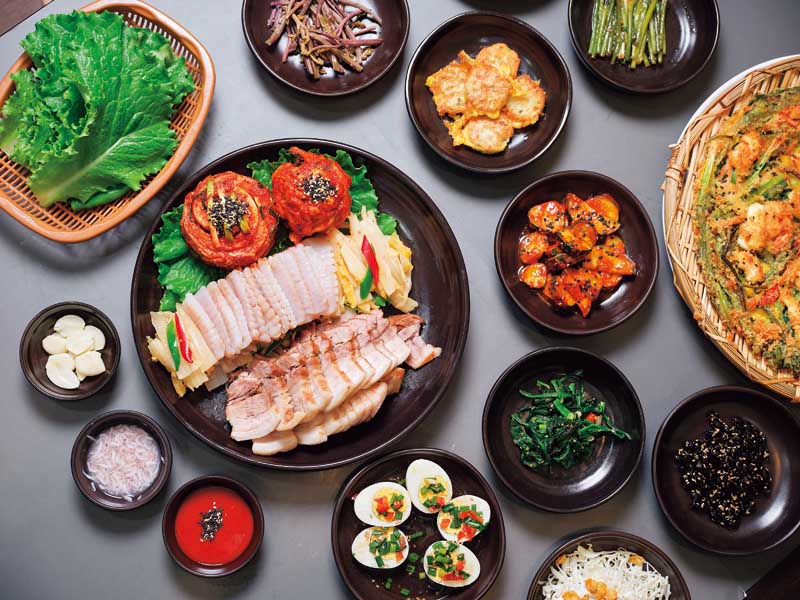
The term “samhap” means “three things that go well together.” In hongeo samhap, it refers to the pairing of fermented skate, boiled pork slices, and kimchi. Best eaten with well-aged kimchi, the sharp taste and pungent aroma of hongeo deliver a powerful kick to the senses. The dish is often served with a bowl of chilled makgeolli, a popular alcoholic beverage made from rice.
© Lee Min-hee
Though only the third-largest city in South Jeolla Province, Mokpo is widely regarded as the region’s culinary capital. Located at the southwestern tip of the Korean peninsula, where the West Sea meets the southern waters, the city enjoys a year-round bounty of fresh seafood and abundant harvests from the vast plains beyond. No one can claim to be a true connoisseur of Korean cuisine until they’ve visited Mokpo. From fresh croaker and pike conger caught just off the coast to the pungent, tangy bite of gat kimchi (mustard green kimchi), Mokpo offers countless beloved specialties.
In 2019, Mokpo declared itself the “City of Taste” and unveiled a list of nine local delicacies that best represent its culinary heritage: saebal nakji (live whiparm octopus), hongeo samhap (fermented skate served with boiled pork and kimchi), mineo hoe (sliced raw croaker), kkotge muchim (spicy raw marinated crab), galchi jorim (braised hairtail), byeongeo hoe (sliced raw silver pomfret), junchi muchim (spicy raw herring salad), agwitang (monkfish soup), and ureok ganguk (rockfish soup). With so many exceptional, time-honored dishes, visitors often don’t know where to start — hence the city’s list of must-try specialties, the “Nine Flavors of Mokpo,” each as deserving as the next.
AN ACQUIRED TASTE
When it comes to fare that defines Mokpo, hongeo samhap reigns supreme. Once shunned for its strong smell and sharp, pungent flavor, this distinctive dish, pairing fermented skate with kimchi and tender slices of boiled pork, has become a coveted delicacy. More than just a Mokpo specialty, hongeo holds a central place in Jeolla cuisine and is emblematic of the region’s identity. A member of the ray family, it is caught throughout the West Sea, including around Yeonpyeongdo and Daecheongdo, islands close to the Northern Limit Line. But the most prized variety comes from Heuksando, about 50 nautical miles (approx. 93 km) off Mokpo’s coast. Their rarity adds to their value, as females produce no more than two offspring a year. The fishing season runs from November to March, when hongeo reach their peak flavor.
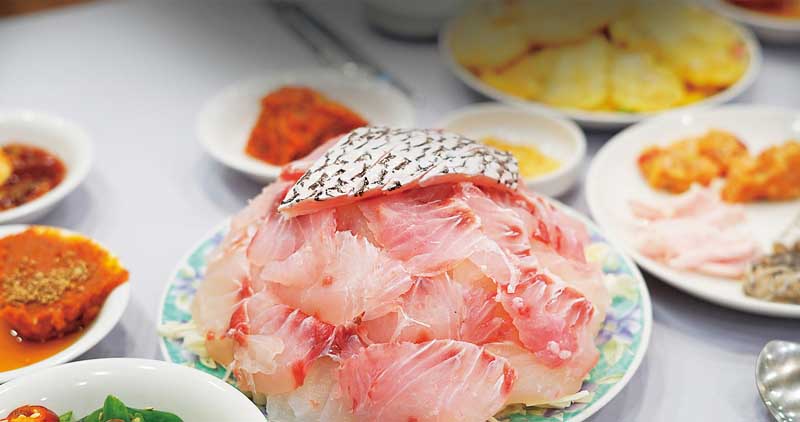
Croaker, a prized summer delicacy from Korea’s western and southern coasts, is valued for its restorative qualities and usually eaten steamed or raw. Called mineo hoe when raw, it has a chewy texture and subtle sweetness. While only the flesh is consumed in other regions, restaurants in Mokpo also serve the skin, swim bladder, and fins, drawing food enthusiasts to the city each croaker season.
© Mokpo City
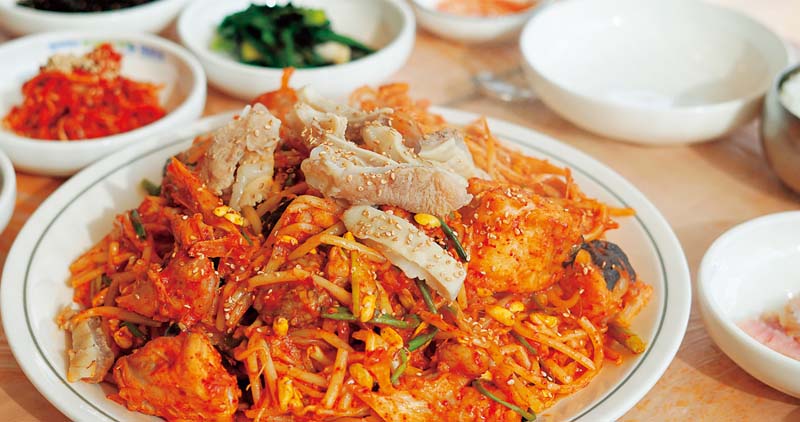
Agwi jjim is a dish of braised monkfish with bean sprouts, water dropwort, sea squirt, and other ingredients seasoned with red pepper powder and thickened with starch. Once dismissed for being ugly and unappetizing, monkfish has become an expensive delicacy thanks to the nationwide popularity of agwi jjim.
© Mokpo City
Widely considered the finest in Korea, most Heuksando skate is auctioned at Mokpo’s fish market before being distributed nationwide. While mainland Koreans often assume hongeo must always be fermented, Heuksando locals also enjoy it fresh. There are two prevailing theories about the origins of fermenting skate. The first traces back to the late Goryeo and early Joseon periods, when the southern coast suffered frequent, devastating raids by Japanese pirates. To minimize casualties, the king evacuated residents under his “empty island” policy. When Heuksando’s inhabitants moved to nearby Naju on the mainland, they brought skate with them, wrapped in layers of rice straw. By the time they arrived, however, the fish had developed a pungent smell, as though spoiled. Unwilling to waste it, they decided to try it anyway, only to find that the skate was perfectly safe to eat and even more flavorful. The straw had allowed the fish to ferment naturally, transforming it into a kind of superfood. The second theory relates to trade practices. The Heuksando locals carried skate to Naju on the mainland to barter for grain. If the journey took longer than planned, the fish would begin to spoil. Rather than discard it, they ate it and found it not only delicious but also easy to digest. They began selling it at the market, where it became highly sought after.
While both theories seem plausible, the fact remains that the strong smell and sharp, pungent flavor of hongeo make for an acquired taste for all but the most adventurous diners. Notably, skate never actually spoils, owing to the high concentration of urea in its body. When the fish dies, the urea breaks down into ammonia and trimethylamine, which produce compounds that preserve the flesh and create its signature aroma and flavor. This is why fermented skate long remained a delicacy almost exclusively enjoyed by Jeolla locals. Only in the past decade has it gained nationwide acclaim, as Korea’s rapidly evolving culinary scene sparked a search for unconventional flavors and the fish’s health benefits became widely known. Today, its fame has gone beyond Korea’s borders, appearing on Culinary Class Wars, the first Korean unscripted series to reach No. 1 on Netflix’s Global Top 10 of non-English shows, and the YouTube channel Korean Englishman, hosted by Josh Carrott, which has more than six million subscribers.
Among Mokpo’s top hongeo restaurants, Deoginjip is one of the oldest. It’s known for hongeo aetang, a soup made with skate liver and doenjang (fermented soybean paste) that’s regarded as an ultimate health food. Nearby Mokpo Ramyeon Hongeo Ramyeon has also risen to online fame for its signature pairing of fermented skate with instant noodles.
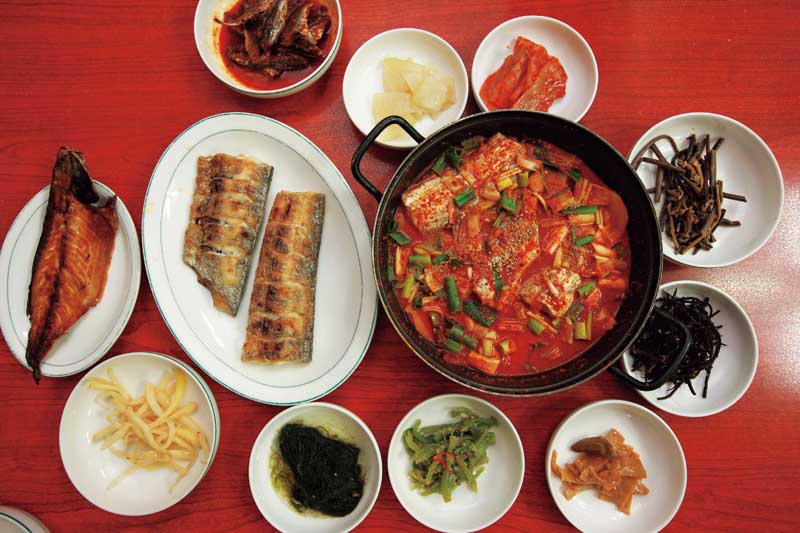
Large pieces of hairtail braised in spicy sauce make galchi jorim, a dish enjoyed both at home and when dining out. Pan-fried hairtail is equally popular for its clean, mild flavor. Black hairtail, caught off Mokpo’s coast from late September, just before spawning season, is particularly prized for its sweet, superior taste.
© Korea Tourism Organization
SEAFOOD LOVER’S PARADISE
Croaker (mineo) is caught mainly around Amtaedo and other islands off Mokpo. Sliced raw mineo is prized as a restorative dish to beat the summer heat. Once a rare delicacy reserved for Joseon kings, it is now readily available along Mokpo’s “Croaker Street,” lined with establishments like Yeongnan Hoetjip and Jungang Hoejib.
Mokpo is also famous for whiparm octopus (nakji), which ranks alongside skate as one of the city’s most memorable foods for foreign visitors. Living in rocky crevices and tidal flats, this small octopus is notoriously difficult to catch. With a lifespan of barely a year, it must be gathered by hand along the West Sea’s tidal flats, where it feeds on small crabs, shrimp, and other shellfish. Nutrition packed, nakji can be prepared in many ways. Nakji tangtangi, for instance, is live octopus chopped into small pieces and mixed with raw beef and egg yolk. Nakji chomuchim is also made with chopped octopus but mixed with assorted vegetables and a tangy vinegar-based sauce. The most celebrated nakji dish may be yeonpotang, a soup made by simmering a whole octopus in a savory vegetable broth. It’s served nationwide but truly exceptional in Mokpo. Yeonpotang is unrivaled as a hangover cure, and historical records praise it for replenishing vital energy, called gi in Korean.
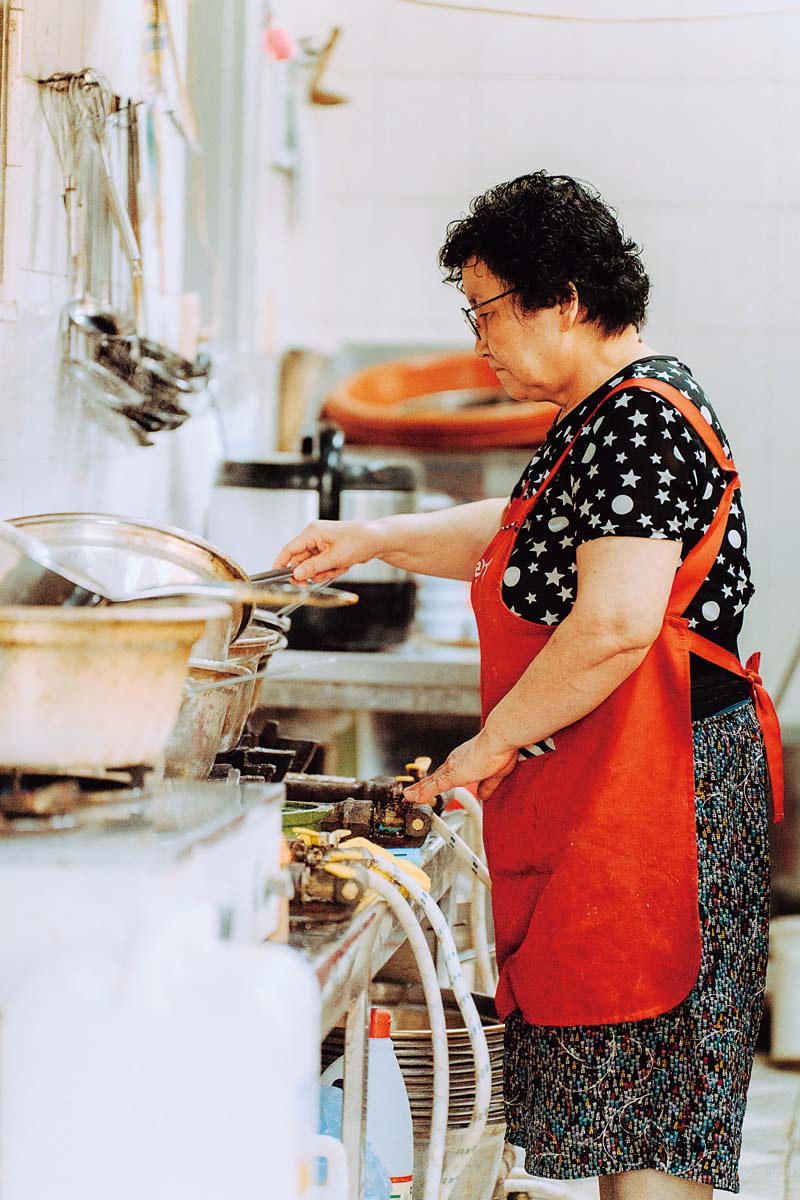
Garakji Jukjip in Mokpo’s Namgyo-dong has been open for 75 years. For six decades now, Bae Ok-lim has carried on her parents’ legacy, earning wide renown for her gifted cooking. Specializing in rice porridge dishes and knife-cut noodles, the restaurant is especially famous for its patjuk (red bean porridge made from local beans) and ssuk gulle (mugwort rice cakes coated in white bean powder).
Courtesy of Don’t Worry Village
Another very popular dish is gesal bibimbap, rice mixed with freshly shelled blue crab meat and a flavorful sauce. At Jangteo Sikdang, where it’s the house specialty, there’s always a crowd. Local chefs, famed for their masterful touch with food, know how to bring out the best in silver pomfret, herring, hairtail, and other varieties of fish, whether simmered as jorim or deep-fried as twigim. As for rockfish, while it is mostly eaten raw elsewhere in Korea, in Mokpo it is prepared as ureok ganguk, a soup made from the semi-dried variety. It is considered one of the best hangover cures alongside yeonpotang.
FOUND ONLY IN MOKPO
While jjajangmyeon (a noodle dish topped with sauces varying by region) originated from a Chinese dish, the Korean version has a distinctive flavor of its own. It is made by stir-frying Korean-style chunjang (fermented black bean paste) with diced pork, onions, and zucchini, then thickening the sauce with starch. Although now prepared much the same way across the country, regional variations exist, with some restaurants topping it with a fried egg, for instance, and others substituting pork with beef.
In Mokpo, the dish takes on a local twist. Jungkkan is a jjajangmyeon variation that was first served at Junghwaru, a family-run restaurant operating for over seventy years across three generations. In the 1970s and ’80s, local diners often ordered giseumyeon (a Korean take on Chinese chicken noodle soup) or jjajangmyeon to finish off a meal centered on main dishes such as tangsuyuk (Korean-style sweet and sour pork). But by the time these follow-on dishes arrived, diners were often too full to finish them. To reduce waste, the second-generation owner created a lighter version of jjajangmyeon using thinner noodles and finely minced vegetables and meat, giving it a porridge-like consistency. Easy to eat, jungkkan quickly won over customers. First served only as a light accompaniment to the main meal, it eventually surpassed regular jjajangmyeon in popularity. By the mid-2000s it had earned a permanent place on the menu, and in 2022 the name was registered as a trademark. Even today, jungkkan is available only at Junghwaru.
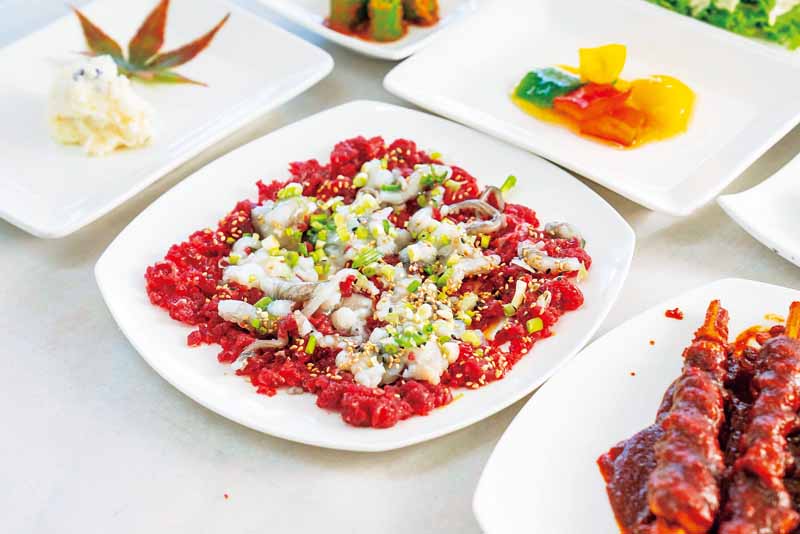
Among Mokpo’s iconic specialties is whiparm octopus, or saebal nakji, a small-bodied octopus species with long, thin arms that is prized for its delicate flavor. Pictured here is nakji tangtangi, a dish of chopped live octopus mixed with thinly sliced raw beef.
© Korea Tourism Organization
Another Mokpo institution, Sukule, has been around for nearly seventy years. It is famed for its mugwort rice cakes, a dessert coated in white bean paste and accompanied by a generous serving of rice syrup.
The growing acclaim of Korean cultural content — from K-pop to Squid Game — has fueled worldwide interest in Korean cuisine. One example is gimbap, whose popularity has soared in recent years. Netflix’s animated film KPop Demon Hunters features a scene in which one of the protagonists devours an entire roll of gimbap in one piece. It’s worth noting that the laver (gim) used for gimbap is primarily harvested in the Jeolla region, including Mokpo’s coast. The region is also home to a traditional dish made with mulgim, the term for fresh seaweed that hasn’t been dried yet. Boiled with octopus, fish, and other seafood, mulgim yields a soup rich with the aromas and flavors of the sea.
It’s no wonder that some refer to Mokpo as not just the city but the capital of taste. The praise is well deserved.